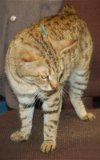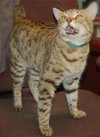 |
Come visit us at our location in Sanford directly behind the Paw Park Dog Park
We are currently open by appointment ONLY.
Click HERE for appointment information.
 |
 |
 |
 |
|
|
Click on any image above for more info.
|
||||
Chausie (short coat) : : Male (neutered) : : Adult : : Large
|
| My Rescue |
| Login to Remember your Favorite Animals and Breeds! |
Golden Tut the Chausie Jungle Cat needs a caretaker or foster! Won't you consider helping him get a new start?
About Golden Tut the Chausie Jungle Cat | |
|
|
07/08/09 Volunteer Update: For all his "wild cat" looks, he is as domestic as they come and loves to be stroked. He wants to be the center of attention, and if you aren't giving him enough of it, he will tell you so. But his gentle nature and beautiful coloring makes it hard to ignore him anyway.
The first Chausies were Jungle Cat hybrids, and were bred in the late 60's and early 70's. These early hybrids were created to offer those interested in exotic cats a more reasonable alternative to the often ill-fated attempts to make pets out of wild animals. Many different domestic cats were used in the beginning, but at the current time, the only permissible outcrosses are the Abyssinian and the domestic shorthair.
The Chausie was given foundation registry status in The International Cat Association (TICA) in 1995. In February 2001 the breed was advanced to Evaluation status (effective May 1, 2002). In May 2003, the Chausie achieved 'Advanced New Breed' status and now competes in the Advanced new Breed (ANB) rings in TICA shows. ANB is the level prior to a new breed becoming a Championship Breed - the Chausie is currently working towards this goal.
WHAT IS A JUNGLE CAT? The first historical record of the Jungle Cat was found in ancient Egypt, where both the Jungle Cat and the African Wild Cat were used for hunting wild waterfowl. Mummified Jungle Cats have been found in Egyptian tombs, attesting to the high regard in which they were held. Some say that the statues of the goddess Bastet were modeled after Jungle Cats and we can certainly see the resemblance in her long, slender body and large ears! The name, Chausie, is derived from the Latin name for the Jungle Cat, Felis chaus, which occurs widely from the Nile Valley north to Turkey and the Caspian Sea, and eastward through South Asia as far as Vietnam. Jungle Cat is a generic sounding term, and people sometimes assume it refers to any wild cat whose habitat is jungle or forest. However, the Jungle Cat is a distinct species, with 9 subspecies, and is one of the largest of the small cats (genus Felis). In the wild, Jungle Cats have been reported ranging from 18 to 30lbs. However, the Chausie, although resembling the Jungle Cat, will be quite a bit smaller than this. The chief habitats of the Jungle Cat are wetlands and river valleys. It preys on rodents and other small animals, but occasionally will eat the young of larger animals as well. This cat also flourishes in proximity to humanity, attracted by the rodents, which congregate in irrigated fields. In India, Felis chaus has been found nesting in abandoned granaries and houses. Probably because of this flexibility, Felis chaus populations are stable and the species is not considered endangered. Felis chaus is closely related to Felis sylvestris, which is widely considered to be the ancestor of modern domestic cats, and for this reason it is able to interbreed with domestic cats. Jungle Cats are exotic wild animals and as exotics they require special permits (in some areas), special diets, housing to maintain, and a commitment for the lifetime of the animal as many exotics do not re-home well. The TICA Chausie Breed Committee does not recommend Jungle Cats or any wild animals as house pets which is why we strive to recreate the elegant beauty of the Jungle Cat in the domestic Chausie.
More about Golden Tut the Chausie Jungle Cat


Other Pictures of Golden Tut the Chausie Jungle Cat (click to see larger version):














Copyright © Pet Rescue by Judy






